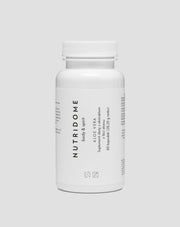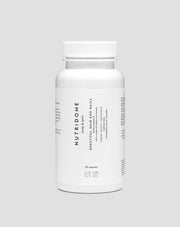

Health Labs Care Solve On light ceramide repair cream
-
soothes irritation and redness
-
moisturizes and reduces skin discomfort
-
stimulates epidermal regeneration
- 50 ml
What distinguishes the repair cream with ceramides?
Zinc in combination with hyaluronic acid (zinc-HA) and pyroglutamic acid (zinc-PCA) supports repair processes in the damaged epidermis and regulates sebum secretion. The ceramides (NP, AP, EOP) contained in the cream, combined with vegetable emollients, promote the regeneration of the epidermal barrier and replenish deficits in the intercellular cement, so the product reduces dryness and redness of the skin. Repair Cream with Ceramides contains isolated asiaticosides, which reduce oxidative stress on skin cells and reduce skin reactivity, as well as lactoferrin, which accelerates the epidermal healing process and soothes irritation and redness. The formula of the Repairing Cream with Ceramides was created with the cooperation of chemists, biotechnologists, chemical technologists with many years of experience in the cosmetic industry and cosmetologists specializing in therapies for problematic skins.
Choose when your skin needs... reduce the appearance of acne lesions, reduce inflammation, moisturize and soothe irritation, regenerate the lipid barrier, restore proper moisture levels, support the balance of the skin microbiota.
Multi-component restoration of problematic skin
- stimulates epidermal reconstruction thanks to an innovative combination of zinc with hyaluronic acid (zinc-HA) and pyroglutamic acid (zinc-PCA)
- moisturizes, soothes irritation and reduces skin discomfort
- light, non-comedogenic texture does not weigh down the skin and works well under makeup
- Lactobacillus ferment contained in it rebuilds damaged skin microbiota
- moisturizes skin, protects against dryness and leaves skin smooth to the touch, as confirmed by 97% of respondents
Learn about the ingredients in your cream.
-
Ceramides - are a group of organic chemical compounds classified as sphingolipids, which are a key part of the binder that fills the spaces between the cells of the stratum corneum. Deficiencies of ceramides in the epidermis result in increased permeability of the epidermal barrier, which leads to increased transepidermal water loss and a decrease in epidermal hydration, while a dysfunctional lipid barrier increases the risk of skin irritation.
-
Zinc hyaluronate (zinc-HA) and zinc pyrroglutamate (zinc-PCA) - a combination of zinc with hyaluronic acid (zinc-HA) and pyrroglutamic acid (zinc-PCA) are used in the treatment of problematic skins for their antibacterial, soothing and seboregulatory effects. Zinc-PCA additionally reduces the conversion of testosterone to dihydrotestosterone, which has a 3-fold higher affinity for androgen receptors present in the skin than testosterone. Both androgensstimulate sebum production and enhance keratinization. Zinc hyaluronate, on the other hand, combines the sebum-regulating effects of zinc and the moisturizing functions of hyaluronic acid.
-
Lactoferrin - a protein naturally produced by our body, essential in immune building processes. It is present in many body fluids and glandular secretions, such as milk, saliva, tears, nasal cavity gland secretions. Stimulates the process of keratinocyte differentiation, wound healing and skin lesions. Acts as a protein with the ability to combine with iron ions, which makes it more easily absorbed by the body.
-
Centella asiaticaextract - Centella asiatica (also known as Gotu kola), or Centella asiatica, is a plant of the Apiacae family of umbelliferous plants. It is a traditional plant that has been used for medicinal and cosmetic purposes for thousands of years. It is characterized by an extremely broad spectrum of uses, mainly due to the presence of pentacyclic triterpene saponins (Asiaticoside, Madecassoside) and tannins, which have antioxidant and anti-inflammatory properties. Gotu kola is still used today to treat wounds, burns and scars. In cosmetic products it has found use in protecting the skin from oxidative stress, stimulating epidermal renewal processes and soothing irritation.
-
Linoleic acid and linolenic acid - are ingredients with regenerative effects on the epidermal barrier and anti-inflammatory properties. They reduce skin irritation and increase the level of epidermal hydration.
-
Hyaluronic acid - intensively moisturizes and reduces water loss through the epidermis. It increases skin hydration, promotes skin regeneration and also has an anti-aging effect. Depending on its molecular weight, HA has different properties: particles of smaller size more easily penetrate the epidermal barrier, providing hydration in the upper layers of the epidermis, high-molecular hyaluronic acid does not penetrate the epidermis, but by binding water molecules from the environment, it creates a moist compress on the surface of the epidermis, which reduces the feeling of tightness and dryness of the skin.
-
Panthenol - a substance that soothes skin irritation and accelerates the regeneration process. Reduces dryness of the skin.
-
Trehalose - is mainly known for its ability to protect proteins and other biomolecules from stressful conditions: very high and very low temperatures, under dehydration and osmotic stress. Increases the hydration level of the epidermis. Exhibits photoprotective properties.
-
Pear Juice Ferment Filtrate - The addition of Lactobacillusferment (Lactobacillus/Pear Juice Ferment Filtrate) supports the skin's microbiota and helps restore its balance, which has a positive effect on problematic skin. People with problematic skin often face dysbiosis (imbalance of the skin microbiota). The prevalence of certain (IA1) strains of C. acnes bacteria with greater pathogenicity makes these individuals more prone to acne lesions.Lactobacillus ferment
- Lactobacillusferment from rapeseed and wheat - is a postbiotic that promotes the balance of the skin microbiota, which translates into an improved epidermal barrier.
Health Labs Care S.A.
ul Klimczaka 1, 02-797 Warsaw segment E kontakt@healthlabs.pl

